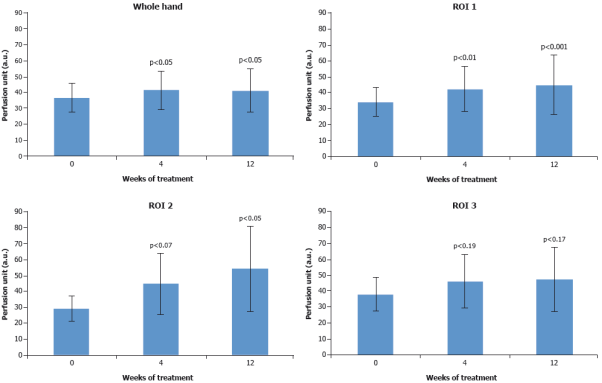Session Information
Session Type: Abstract Submissions (ACR)
Background/Purpose: Digital ulcers (DU) are complications of systemic sclerosis (SSc) and arise as a result of ischaemia due to vasculopathy of the digital arteries (1). Rosato et al (2) found that SSc patients, who had pulmonary arterial hypertension (PAH) and were treated with bosentan, had improved blood flow in the hands over time. However, as patients with active DU were excluded from their study they were unable to relate blood flow to the presence of DU. This is the first study to examine the relationship between blood flow in the hands of SSc patients and the presence of digital ulcers (DU). Additionally, the effect of bosentan on blood flow in the hand was assessed in a subset of patients who had reduced blood flow relative to healthy subjects.
Methods: Adult patients with SSc and a recent history of DU and healthy subjects were included. Patients were classified into 4 subgroups: no current DU or pitting scars; pitting scars only; new DU; or persistent DU. The hand was categorised into three regions of interest (ROI) and blood flow was measured by laser Doppler perfusion imaging at baseline, 4 and 12 weeks. Patients who had a reduction in blood flow of more than 50% relative to healthy control subjects in ROI 1 on baseline, in at least one of the hands, were treated with bosentan for 12 weeks.
Results: Fifty-two SSc patients and 51 healthy subjects and were included in the analysis. There was no significant difference in blood flow in the hand across the patient subgroups at baseline. Sixteen SSc patients had a reduction of blood flow of ≥50% versus healthy subjects and received bosentan. Bosentan significantly (p<0.05) increased the blood flow in the whole hand after 12 weeks compared with baseline (shown in figure 1).
Conclusion: No relationship was found between blood flow in the hands of SSc patients and presence of DU. After 12 weeks of bosentan treatment the blood flow had increased in the SSc patients but had not normalised to that of healthy subjects.
References
1. Strange G, Nash P. The manifestations of vasculopathy in systemic sclerosis and its evidence-based therapy. Int J Rheum Dis 2009;12:192–206.
2. Rosato E, Molinaro I, Borghese F, et al. Bosentan improves skin perfusion of hands in patients with systemic sclerosis with pulmonary arterial hypertension. J Rheumatol 2010;37:2531–9.
|
Figure 1. Change in blood flow from baseline to week 4 and 12 with bosentan treatment
Disclosure:
J. Meijs,
Actelion Pharmaceuticals,
2;
A. J. M. Schuerwegh,
Actelion Pharmaceuticals,
5;
A. E. Voskuyl,
Actelion Pharmaceuticals,
5;
J. P. J. Bloemsaat-Minekus,
Actelion Pharmaceuticals ,
3;
M. C. Vonk,
Actelion Pharmaceuticals US,
5.
« Back to 2013 ACR/ARHP Annual Meeting
ACR Meeting Abstracts - https://acrabstracts.org/abstract/blood-flow-in-the-hands-of-a-predefined-homogeneous-systemic-sclerosis-population-the-presence-of-digital-ulcers-and-the-improvement-with-bosentan/

